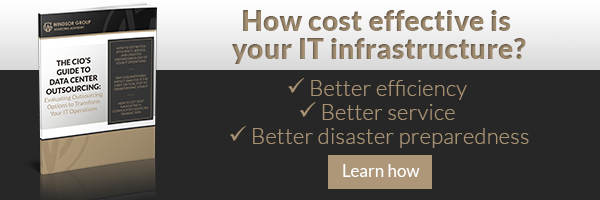 Making the right decisions about data center outsourcing involves the same sort of cost-benefit analysis you’d use to evaluate other potential initiatives. Sometimes that process is fairly straightforward, but in the case of data center operations, the complexities of your operation and implications of change can have a profound effect on costs.
Making the right decisions about data center outsourcing involves the same sort of cost-benefit analysis you’d use to evaluate other potential initiatives. Sometimes that process is fairly straightforward, but in the case of data center operations, the complexities of your operation and implications of change can have a profound effect on costs.
Here are three costs you should consider as part of your decision-making process:
1. The cost of the status quo.
It’s commonly understood that outsourcing can bring direct savings over handling the same work in-house. Through consolidation and standardization of processes, data center outsourcing can specifically help you save on new technology, maintenance and staffing as well as energy usage and physical space. Outsourcing can also help you better manage risk, to avoid potentially catastrophic costs.
You’ve thoughtfully examined your current situation, so you know your real out-of-pocket costs and understand the indirect financial ramifications of current data center operations. Considering data center outsourcing probably means you’re facing aging data center assets that bring diminishing returns. You’re no longer able to keep pace with growing needs or adequately meet increasing regulatory requirements.
The question to ask yourself now is: what will happen if you do nothing? If you simply continue to operate as is, how will that affect day-to-day function as you move forward, in term of services you’re able to provide, staff productivity and customer experience?
What will be the cost if you can’t remain competitive? Alternatively, if you’re able to save through data center outsourcing, what could you do with those funds?
2. The cost of change.
Are your people – not just your IT staff but your entire population of employees – ready for transformational change? It’s possible data center outsourcing won’t have much of a ripple effect throughout your company, since one of your goals is to at least maintain existing service levels and quality.
But no transition is truly seamless. And if your switch to data center outsourcing constitutes a major overhaul, it’s likely to affect the way all departments do their work, receive support, etc. Some companies are culturally more accepting of innovation and change.
How will your people respond?
3. Data center outsourcing isn’t free.
The most important cost you’ll need to consider is the pricing structure. What will actually be most cost-effective for you? This is an evolving area, but an experienced IT consulting firm can help you make sense of the options as they relate to your company’s specific needs and priorities.
Pricing can be based on:
- Consumption. You pay for what you use, but you have to be strategic. Saving money when you should be paying for increased service may not be smart.
- Incentives. As the name implies, you pay a bonus for above-SLA performance. Don’t assume this is a required companion piece to charging penalties for under-performance.
- Gain-sharing. What you pay is based on the value you receive above certain baseline expectations. Since that fluctuates, you can’t predict costs in advance.
- Shared risk-reward. Perhaps the most collaborative approach, with this option you share both costs and rewards of developing new solutions or specific products. In a way, you’re taking on a partner.
There are so many variables. What’s right for your company won’t be exactly the same as someone else’s best solution. In the end, the costs associated with your decision to move forward with data center outsourcing – both tangible and intangible – depend on what your future vision looks like and your functional priorities for turning that vision into a reality.
Photo Credit: Images of Money


